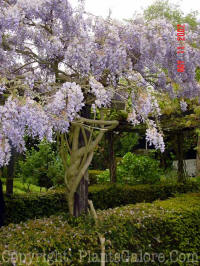
 Wisteria
vines are among the most beautiful and
frustrating plants for the home landscape.
When in bloom, they are hard to beat for
their long tresses of flowers. However, the
most common complaint about wisteria is that
they may take a long or very long time
before they start to bloom.
Wisteria
vines are among the most beautiful and
frustrating plants for the home landscape.
When in bloom, they are hard to beat for
their long tresses of flowers. However, the
most common complaint about wisteria is that
they may take a long or very long time
before they start to bloom.
 There are
many proposed techniques to overcome this
problem but none of them is proven to work
on all vines at all times. Some say root
pruning helps while others say you should
prune the vine back severely to stimulate
flowering. Another recommendation is to
fertilize with superphosphate but, if this
works, it is only because your soils are
deficient in phosphorus. A soil test will
determine the amount of phosphorus in your
soil.
There are
many proposed techniques to overcome this
problem but none of them is proven to work
on all vines at all times. Some say root
pruning helps while others say you should
prune the vine back severely to stimulate
flowering. Another recommendation is to
fertilize with superphosphate but, if this
works, it is only because your soils are
deficient in phosphorus. A soil test will
determine the amount of phosphorus in your
soil.
Another
theory says that they will grow slower but
bloom sooner if planted in sandy soils. The
famed plant explorer,
E.H. Wilson studied wisterias in their
native Japan and claimed that the most
floriferous ones grew next to streams. Oh,
well.
North America
and
Eastern Asia are home to about 10
species of wisteria. Of these two,
Wisteria sinensis (Chinese) and W.
floribunda (Japanese), are by far the
most popular for the home landscape.
The other species include W. brachybotrys,
W. brevidentata, W. frutescens
(American Wisteria), W. macrostachya
(Kentucky Wisteria), W. venusta
(Silky Wisteria), W. villosa
and
W. formosa.
Interestingly, there is a difference between
how various species of wisteria twine
themselves around things as they climb.
Wisteria frutescens, W. macrostachya and
W. sinensis (Chinese) twine from left to right
as they climb. Wisteria floribunda
(Japanese), W. Taiwan and W. venusta climb
by twining from right to left.
The genus was named in honor of
Dr. Caspar Wistar (761-18I8), Professor
of Anatomy at the University of
Pennsylvania. For some reason, the spelling
was changed somewhere along the line to an
er ending rather than ar.



